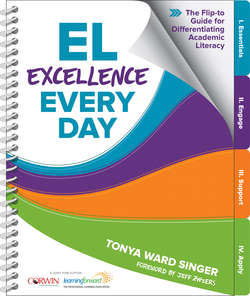Читать книгу EL Excellence Every Day - Tonya Ward Singer - Страница 16
На сайте Литреса книга снята с продажи.
Language Assets:
ОглавлениеThe term English learner refers to English proficiency level only. It doesn’t tell us anything about how many other languages a student speaks, understands, reads, or writes. Some ELs are bilingual. Other ELs are trilingual! Some ELs are academically proficient at grade level in their primary language. Some ELs are experts at translating on the spot, a complex and creative skill. Some ELs have oral fluency in another language but don’t have academic literacy in that language as they have only attended school in English.
In an ideal world, schools help every student be fluent and literate in multiple languages. I certainly wish my local K–8 school provided my own monolingual sons the opportunity to build literacy in multiple languages. I grew up monolingual with a deep desire to be able to communicate in Spanish. U.S. schools didn’t help me realize this vision, but thankfully I had the opportunity to immerse myself in Spanish-speaking communities in the United States and to live and work in both Mexico and Guatemala long enough to think, dream, and express in two languages. I am grateful I lived and worked a year in China, long enough to learn basic communication in Mandarin Chinese—and to experience what it is like to be an outsider to the dominant culture, illiterate in the dominant language of my environment. I became multilingual to expand my world, connect to people with different backgrounds, and see beyond the norms of my home community. Imagine if every child had the opportunity to build such global competency in school!
Research shows that effective bilingual programs are among the most powerful ways to ensure ELs thrive with academic English and rigorous core assessment in English (Thomas & Collier, 2002). Bilingual programs that are systematically and strategically structured to reflect the best practices in the field do not slow English literacy or language learning at all. On the contrary, they accelerate it.
Even if you, like most U.S. teachers, teach ELs in an English-only context and only speak English, you can still build on your EL students’ language assets. In Chapter 2 and throughout this guide, you’ll find strategies to value and build on students’ primary language(s) in your everyday teaching.
